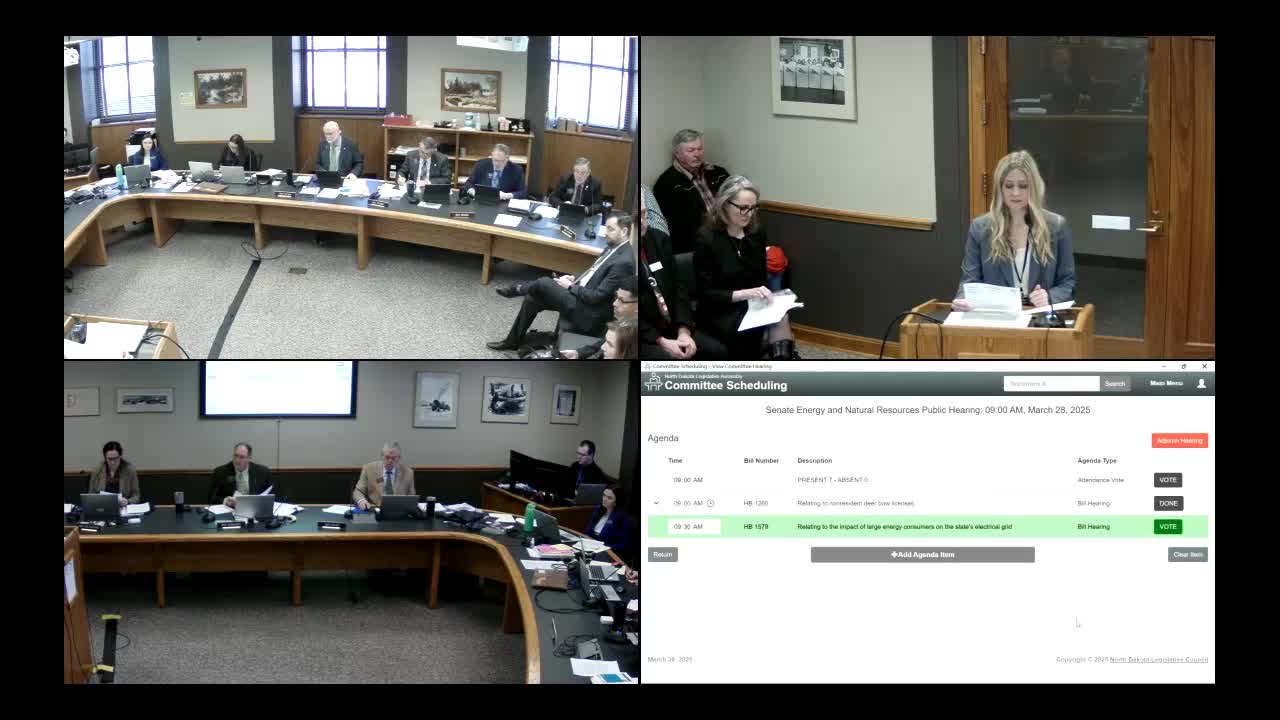Committee advances bill to base nonresident mule deer archery licenses on current-year counts
March 28, 2025 | Energy and Natural Resources, Senate, Legislative, North Dakota
This article was created by AI summarizing key points discussed. AI makes mistakes, so for full details and context, please refer to the video of the full meeting. Please report any errors so we can fix them. Report an error »

Representative Lori Beth Hager, R-Fargo, and the North Dakota Game and Fish Department urged the Senate Energy and Natural Resources Committee to revise state law so nonresident mule deer archery license allocations are based on the current year's mule deer population count. The committee voted to give House Bill 12‑60 a "do pass" recommendation on a 7‑0 voice vote.
Supporters said the current statute ties nonresident archery license allocations to the preceding year's mule deer gun tag allocation, which can misalign permits with current population conditions. "When the mule deer count is taken from a harsh winter, that results in lowering the mule deer population, but the number of deer licenses is based on the previous year," Representative Lori Beth Hager said. She asked the committee for a green vote on the bill.
Bill Hawes, assistant wildlife division chief for the North Dakota Game and Fish Department, testified the change was introduced at the department's request to improve biological management and reduce hunting pressure in the Badlands. Hawes described a working group convened by the department and said the group and a follow‑up hunter survey supported the change. "In 2023 the department issued 862 nonresident any deer licenses following the harsh winter of '22; in reality, if we would have used current license allocations, it should have been 3,307," Hawes said, as an example of how prior‑year baselines can produce allocations out of step with current population measures.
Hawes explained that mule deer are monitored primarily through aerial surveys conducted in spring and fall (when visibility is best), and that gun tag allocations for mule deer currently are adjusted each year based on the most recent data. He also said resident archery licenses remain over‑the‑counter and are not subject to the same allocation limits. Supporters including John Bradley of the North Dakota Wildlife Federation and Brock Wall of Backcountry Hunters and Anglers endorsed the change as a straightforward fix that aligns nonresident archery allocations with other tags and the best available population data.
Senators asked about the composition of the department's working group and the scope of survey work. Hawes said the working group was intentionally small — roughly four to five participants including advisory board members, landowners and representatives of hunting organizations — and that the department also hired a third party that surveyed about 10,000 hunters to inform recommendations.
Senator Gearhart moved a "do pass" recommendation on House Bill 12‑60; Senator Beard seconded. The clerk recorded 7 ayes, 0 nays, 0 absent; the motion passed.
The committee closed the hearing on House Bill 12‑60 and advanced the measure to the next stage with the committee's recommendation.
Votes at a glance
- House Bill 12‑60 — Change nonresident mule deer archery license allocations to use current‑year mule deer counts; mover: Senator Gearhart; second: Senator Beard; committee vote: 7 ayes, 0 nays, 0 absent; outcome: do pass recommendation.
Supporters said the current statute ties nonresident archery license allocations to the preceding year's mule deer gun tag allocation, which can misalign permits with current population conditions. "When the mule deer count is taken from a harsh winter, that results in lowering the mule deer population, but the number of deer licenses is based on the previous year," Representative Lori Beth Hager said. She asked the committee for a green vote on the bill.
Bill Hawes, assistant wildlife division chief for the North Dakota Game and Fish Department, testified the change was introduced at the department's request to improve biological management and reduce hunting pressure in the Badlands. Hawes described a working group convened by the department and said the group and a follow‑up hunter survey supported the change. "In 2023 the department issued 862 nonresident any deer licenses following the harsh winter of '22; in reality, if we would have used current license allocations, it should have been 3,307," Hawes said, as an example of how prior‑year baselines can produce allocations out of step with current population measures.
Hawes explained that mule deer are monitored primarily through aerial surveys conducted in spring and fall (when visibility is best), and that gun tag allocations for mule deer currently are adjusted each year based on the most recent data. He also said resident archery licenses remain over‑the‑counter and are not subject to the same allocation limits. Supporters including John Bradley of the North Dakota Wildlife Federation and Brock Wall of Backcountry Hunters and Anglers endorsed the change as a straightforward fix that aligns nonresident archery allocations with other tags and the best available population data.
Senators asked about the composition of the department's working group and the scope of survey work. Hawes said the working group was intentionally small — roughly four to five participants including advisory board members, landowners and representatives of hunting organizations — and that the department also hired a third party that surveyed about 10,000 hunters to inform recommendations.
Senator Gearhart moved a "do pass" recommendation on House Bill 12‑60; Senator Beard seconded. The clerk recorded 7 ayes, 0 nays, 0 absent; the motion passed.
The committee closed the hearing on House Bill 12‑60 and advanced the measure to the next stage with the committee's recommendation.
Votes at a glance
- House Bill 12‑60 — Change nonresident mule deer archery license allocations to use current‑year mule deer counts; mover: Senator Gearhart; second: Senator Beard; committee vote: 7 ayes, 0 nays, 0 absent; outcome: do pass recommendation.
View full meeting
This article is based on a recent meeting—watch the full video and explore the complete transcript for deeper insights into the discussion.
View full meeting
